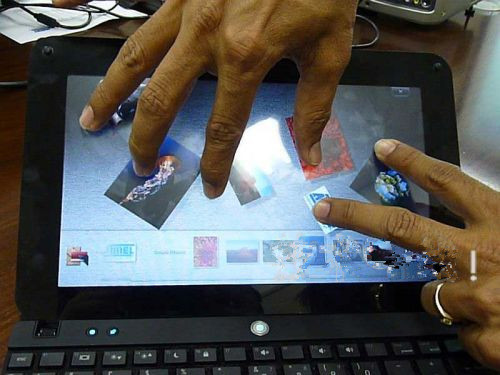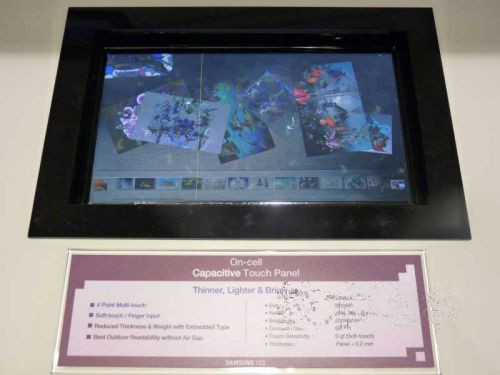Touch panel technology is making rapid progress, and the "common sense" of the past has become unsuitable. For example, the current mainstream resistive touch panel has achieved multi-touch that was once considered "impossible" by 1-2 years ago. The electrostatic capacity type used in portable terminals such as the iPhone is steadily supporting large-size panels, which was previously considered to be "hard". Originally, "liquid crystal integration technology" that failed to achieve mass production due to difficulty in ensuring yield and display performance, with the introduction of the new concept of "On-cell" is expected to become a reality, it is expected that the integrated panel will be as early as 2010. Mass production began in the second half of the year.
This article refers to the address: http://
Resistive film type can achieve multi-touch
France's Stantum uses multi-touch with resistive film. The company has developed a multi-touch detection technology using a digital resistive film type (also known as a matrix resistive film type) instead of the conventional analog resistive film type.
In the conventional analog resistive film type, the entire electrode surface of the upper substrate and the lower substrate is a uniform resistive film (transparent conductive film), and the upper electrode is brought into contact with the lower electrode to detect the position according to the voltage of the conduction point. The digital resistive film type used by Stantum differs from the analog resistive film. The resistive film is formed by using a resistive film forming a linear pattern instead of the entire surface. The touch panel can be formed by facing up and down in the intersecting direction. The company is currently developing a digital resistive touch panel that supports more than 10 inputs.

Digital resistive film touch panel (Stantum) supporting more than 10 inputs
Importing a capacitive panel into a tablet terminal and a personal computer
At present, companies are promoting the development of large-capacity panels of electrostatic capacity. In addition to the conventional mobile phones, it is also planned to expand the market area of ​​electrostatic capacitive touch panels to tablet terminals and personal computers.
3M Company of the United States exhibited a 22-inch LCD monitor with an electrostatic capacity touch panel at the AV Equipment Exhibition "InfoComm2010". It can detect 20 points at the same time. It is said that it is equipped with three electrostatic capacitance type detection ICs.
Atmel will begin mass production of controller ICs for electrostatic capacitive touch panels that support up to 15-inch displays by the end of June 2010. In September 2009, the company launched the "mXT224" controller IC for smartphones that supports 2.5 to 5 inches of small screens. An evaluation kit based on a 10.1-inch capacitive touch panel was made using three controller ICs and one MCU, and work demonstrations were given to mobile phone manufacturers and PC manufacturers (see this site report).
Hitachi High-Tech is currently selling controller ICs that support displays larger than 7 inches, and plans to release controller ICs that support up to 8.9-inch displays in 2010. The controller IC manufactured by Taiwan's FocalTech Systems, which is sold by Hitachi High-Tech, features a mutual-capacity detection method that has multi-touch detection accuracy and response speed of the electrostatic capacitive touch panel. Advantage. It is reported that a controller IC can support up to 8.9 inches of display.

10.1" Capacitive Touch Panel Demo (Atmel)
Debut with LCD integration technology
The integration with the liquid crystal can reduce the thickness and reduce the weight. The integration technology of LCD and touch panel will be unveiled in the second half of 2010. Current touch panels are approximately 1 mm thick. This is equivalent to about 7% of the thickness of the iPad. If an external touch panel member can be integrated with a liquid crystal, it is expected to be thinner and lighter.
The In-cell technology in which a touch sensor function is embedded in a pixel of a liquid crystal has been proposed in the past, but it has been difficult to ensure the yield and display performance, and thus mass production has not been promoted. The use of complex semiconductor fabrication processes to embed the touch sensor function inside the pixels on the TFT array substrate has become a stumbling block to ensure yield. In addition, after the touch sensor is embedded in the pixel, the area that can be used for display is reduced, which is one of the causes of deterioration in image quality.
However, the advent of "On-cell" technology completely changed the situation. The technology can be integrated on the color filter substrate instead of the pixels on the TFT array substrate. Since it is only necessary to form a simple transparent electrode between the color filter substrate and the polarizing plate, it is easy to ensure the yield. In addition, since the effective display area area in the pixel does not decrease, image quality deterioration hardly occurs. The former practice of embedding a touch sensor function inside a liquid crystal panel is called "In-cell", and the latter can be configured with a touch sensor function on a liquid crystal panel, and is therefore called "On-cell". Panels using this technology will begin mass production in the second half of 2010 and are expected to be adopted by large mobile phone manufacturers.

Construction of On-cell type projection type electrostatic capacitance type touch panel (Samsung Electronics)
The share of different ways of touch panels changes rapidly
The share of various types of touch panels has also changed to reverse the "common sense" of the past. Until 2 to 3 years ago, the resistive film type has an absolute advantage of over 70% for a long time. However, with the launch of the iPhone in 2007, the impact of the electrostatic capacity on the entire market has rapidly increased. After the launch of the iPad in 2010, the status of the electrostatic capacity has further improved.
According to the survey conducted by DisplaySearch in the United States, in the supply of $4.3 billion in touch panels in 2009, the ratio of resistive film type is about 50%, and the electrostatic capacity type is close to about 35%. The company predicts that in 2010, with the expansion of the smartphone market and the introduction of the iPad, "the electrostatic capacity type will be translocated with the resistive film type." By 2016, the electrostatic capacity type will "more than 50%."

Best Budget I7 Laptop is everyone eager to. Laptop Intel Core i7 is the No. 1 processor clients choose when they are searching for a performance Gaming Laptop,cause it`s of excellent powering, bigger Solid State Drive, usually 512GB based, full HD 16:9 aspect ratio slimmer display bezels, bigger battery-12000mAh-no need to worry lack of power, fingerprint reader, backlight keyboard, etc. What is intel Core I7 Laptop Price? Usually 300-400usd. You can get Intel i7 11th Generation Laptop, Intel i7 10th Generation Laptop, Intel I5 11th Generation Laptop, Laptop I3 11th Generation,etc. 15.6 or 14 inch all available for i7 processor.
Cooperating with us, you just need to share all your requirements details, like size, cpu, ram, rom, battery, fingerprint, backlight, enter button numbers, SSD+HDD or only SSD ok, if need oem service, if need logo position, special apps preinstall if need, etc. Can provide matched and value feedback in 1-2 working days.
The reason why clients choose us is that just half of DOA than others, longer warranty time, smaller MOQ, fast delivery, competitive cost, good after-sale service, etc.
Laptop Intel Core I7,Intel Core I7 Laptop Price,Best Budget I7 Laptop,Intel I7 11th Generation Laptop,Intel I7 10th Generation Laptop
Henan Shuyi Electronics Co., Ltd. , https://www.shuyicustomtablet.com